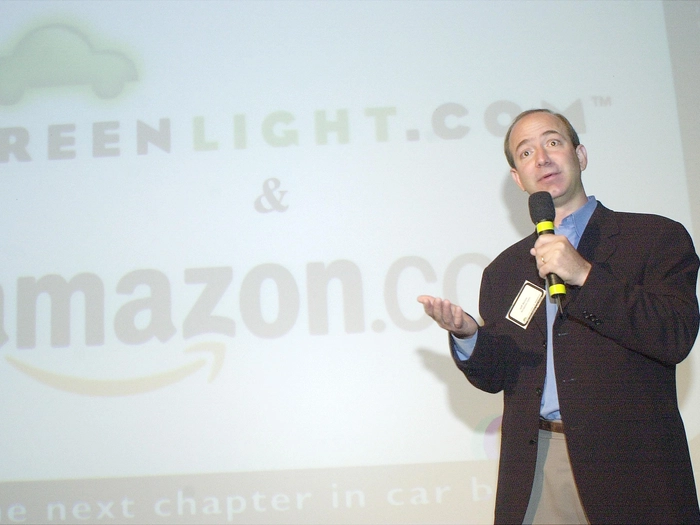Amazon: From Online Bookstore to Tech Empire
Chapter 1: The Birth of a Visionary (Pre-1994) The early 1990s were a time of tectonic shifts in both politics and technology. The Cold War had just ended, giving way to a wave of globalization. Meanwhile, the internet, once a military and academic curiosity, was on the verge of becoming commercially viable. In 1990, Tim Berners-Lee introduced the World Wide Web, and by 1993, web browsers like Mosaic were making the internet accessible to the average user. Amid this digital dawn, a Wall Street executive named Jeff Bezos was working at D.E. Shaw, a prestigious hedge fund. Bezos, a Princeton graduate with a background in computer science and electrical engineering, came across a stat that changed everything: internet usage was growing at 2,300% per year. Bezos immediately recognized the commercial potential of the web. He drafted a list of 20 product categories that could be sold online. Books stood out—they were standardized, easy to ship, and had a vast catalog. In 1994, Bezos left his lucrative job, packed his car, and drove to Seattle with his wife, MacKenzie, to start a company. He called it "Cadabra," but quickly changed it to "Amazon" after the world's largest river, symbolizing the company he hoped to build. Chapter 2: Garage Dreams (1994–1995) Amazon was founded in July 1994 in Bezos' garage. The vision was clear: create an "everything store," starting with books. Seattle was chosen not only for its tech talent but also because it was close to Ingram, a major book distributor. Bezos and his small team built the website by hand. On July 16, 1995, Amazon.com went live. The first book ever sold? Fluid Concepts and Creative Analogies by Douglas Hofstadter. Within 30 days, they were selling books in all 50 states and 45 countries. The site was a hit. Customers were drawn to the convenience and the vast selection. From the start, Bezos instilled a customer-obsessed culture. He would bring an empty chair into meetings to represent the customer. It was his way of reminding employees who they were working for. Chapter 3: Get Big Fast (1996–1999) As the internet gold rush gained momentum, Amazon raised millions in venture capital and went public in 1997 at $18 per share. Bezos was laser-focused on growth over profit. His famous mantra: "Get Big Fast." Amazon expanded into music, videos, toys, electronics, and more. It introduced features like customer reviews, personalized recommendations, and 1-Click ordering, which would become e-commerce standards. In 1999, Time Magazine named Jeff Bezos Person of the Year, recognizing Amazon as a leader in the internet revolution. But storm clouds were gathering. Chapter 4: The Crash That Didn’t Kill (2000–2002) The dot-com bubble burst in 2000. Tech stocks crashed, and many internet startups went bankrupt. Amazon's stock plummeted from over $100 to under $10. Analysts predicted its demise. But Bezos stayed the course. He made difficult decisions: layoffs, cost-cutting, and a renewed focus on operational efficiency. He introduced Amazon Marketplace in 2000, allowing third-party sellers to list products on the platform—a decision that would prove genius. While others folded, Amazon survived. By 2002, it posted its first quarterly profit. The company had weathered the storm and emerged stronger. Chapter 5: Prime Time (2003–2005) To further differentiate itself, Amazon doubled down on logistics. It built cutting-edge fulfillment centers and began experimenting with faster shipping. In 2005, Amazon launched Amazon Prime: for $79 a year, members received unlimited two-day shipping. This was a turning point. Prime increased customer loyalty and lifetime value, and it would eventually include streaming video, music, and more. This period laid the groundwork for Amazon's transformation from an online retailer to a platform with an ecosystem. Chapter 6: The Cloud Beneath It All (2006–2010) Behind the scenes, Amazon had been building robust infrastructure to power its growing retail empire. In 2006, it began offering this infrastructure to other companies through Amazon Web Services (AWS). The first offerings were S3 (Simple Storage Service) and EC2 (Elastic Compute Cloud). AWS was a silent revolution. It allowed startups and enterprises to rent computing power instead of buying expensive servers. Companies like Netflix, Airbnb, and Dropbox built their businesses on AWS. By 2010, AWS had become a multi-billion-dollar business, quietly making Amazon the backbone of the modern internet. Chapter 7: Kindle, Alexa, and Smart Everything (2007–2014) In 2007, Amazon disrupted publishing with the Kindle, its e-reader that made books digital and portable. It wasn’t just a gadget; it was a new business model that cut out publishers. Amazon followed with the Fire tablet, Fire TV, and in 2014, the Echo and Alexa. Alexa brought voice assistants into the home, launching a new

Chapter 1: The Birth of a Visionary (Pre-1994)
The early 1990s were a time of tectonic shifts in both politics and technology. The Cold War had just ended, giving way to a wave of globalization. Meanwhile, the internet, once a military and academic curiosity, was on the verge of becoming commercially viable. In 1990, Tim Berners-Lee introduced the World Wide Web, and by 1993, web browsers like Mosaic were making the internet accessible to the average user.
Amid this digital dawn, a Wall Street executive named Jeff Bezos was working at D.E. Shaw, a prestigious hedge fund. Bezos, a Princeton graduate with a background in computer science and electrical engineering, came across a stat that changed everything: internet usage was growing at 2,300% per year.
Bezos immediately recognized the commercial potential of the web. He drafted a list of 20 product categories that could be sold online. Books stood out—they were standardized, easy to ship, and had a vast catalog. In 1994, Bezos left his lucrative job, packed his car, and drove to Seattle with his wife, MacKenzie, to start a company. He called it "Cadabra," but quickly changed it to "Amazon" after the world's largest river, symbolizing the company he hoped to build.
Chapter 2: Garage Dreams (1994–1995)
Amazon was founded in July 1994 in Bezos' garage. The vision was clear: create an "everything store," starting with books. Seattle was chosen not only for its tech talent but also because it was close to Ingram, a major book distributor.
Bezos and his small team built the website by hand. On July 16, 1995, Amazon.com went live. The first book ever sold? Fluid Concepts and Creative Analogies by Douglas Hofstadter. Within 30 days, they were selling books in all 50 states and 45 countries. The site was a hit. Customers were drawn to the convenience and the vast selection.
From the start, Bezos instilled a customer-obsessed culture. He would bring an empty chair into meetings to represent the customer. It was his way of reminding employees who they were working for.
Chapter 3: Get Big Fast (1996–1999)
As the internet gold rush gained momentum, Amazon raised millions in venture capital and went public in 1997 at $18 per share. Bezos was laser-focused on growth over profit. His famous mantra: "Get Big Fast."
Amazon expanded into music, videos, toys, electronics, and more. It introduced features like customer reviews, personalized recommendations, and 1-Click ordering, which would become e-commerce standards.
In 1999, Time Magazine named Jeff Bezos Person of the Year, recognizing Amazon as a leader in the internet revolution. But storm clouds were gathering.
Chapter 4: The Crash That Didn’t Kill (2000–2002)
The dot-com bubble burst in 2000. Tech stocks crashed, and many internet startups went bankrupt. Amazon's stock plummeted from over $100 to under $10. Analysts predicted its demise.
But Bezos stayed the course. He made difficult decisions: layoffs, cost-cutting, and a renewed focus on operational efficiency. He introduced Amazon Marketplace in 2000, allowing third-party sellers to list products on the platform—a decision that would prove genius.
While others folded, Amazon survived. By 2002, it posted its first quarterly profit. The company had weathered the storm and emerged stronger.
Chapter 5: Prime Time (2003–2005)
To further differentiate itself, Amazon doubled down on logistics. It built cutting-edge fulfillment centers and began experimenting with faster shipping.
In 2005, Amazon launched Amazon Prime: for $79 a year, members received unlimited two-day shipping. This was a turning point. Prime increased customer loyalty and lifetime value, and it would eventually include streaming video, music, and more.
This period laid the groundwork for Amazon's transformation from an online retailer to a platform with an ecosystem.
Chapter 6: The Cloud Beneath It All (2006–2010)
Behind the scenes, Amazon had been building robust infrastructure to power its growing retail empire. In 2006, it began offering this infrastructure to other companies through Amazon Web Services (AWS). The first offerings were S3 (Simple Storage Service) and EC2 (Elastic Compute Cloud).
AWS was a silent revolution. It allowed startups and enterprises to rent computing power instead of buying expensive servers. Companies like Netflix, Airbnb, and Dropbox built their businesses on AWS.
By 2010, AWS had become a multi-billion-dollar business, quietly making Amazon the backbone of the modern internet.
Chapter 7: Kindle, Alexa, and Smart Everything (2007–2014)
In 2007, Amazon disrupted publishing with the Kindle, its e-reader that made books digital and portable. It wasn’t just a gadget; it was a new business model that cut out publishers.
Amazon followed with the Fire tablet, Fire TV, and in 2014, the Echo and Alexa. Alexa brought voice assistants into the home, launching a new era of ambient computing.
These innovations kept Amazon in consumers' homes, not just on their screens.
Chapter 8: The Everything Company (2015–2020)
Amazon went on a shopping spree. It acquired Whole Foods in 2017, signaling its serious move into groceries. It expanded Amazon Go cashier-less stores, invested in AI, logistics, healthcare, and more.
Amazon Studios grew into a serious competitor to Netflix, winning Emmys and Oscars. AWS became the market leader in cloud computing. The company surpassed $1 trillion in market value.
Jeff Bezos became the world’s richest man, symbolizing Amazon’s transformation from scrappy startup to dominant force.
Chapter 9: Changing of the Guard (2021–Present)
In 2021, Bezos stepped down as CEO, handing the reins to Andy Jassy, the head of AWS. The world was emerging from the COVID-19 pandemic, during which Amazon played a crucial role in delivering essential goods.
Amazon now faces new challenges: antitrust scrutiny, unionization efforts, climate concerns, and competition from other tech giants.
Still, it remains a leader in AI, robotics, logistics, and cloud computing. From retail to healthcare to entertainment, Amazon touches nearly every facet of modern life.
Chapter 10: The Legacy of Day 1
Jeff Bezos often talks about "Day 1" — the idea that Amazon must always act like a startup, with hunger, speed, and customer obsession. In his final shareholder letter, he warned of "Day 2": stasis, irrelevance, and decline.
Today, Amazon continues to innovate, pushing into space (via Blue Origin), artificial intelligence, and sustainability. The company started with a simple idea in a garage and evolved into a global infrastructure powering commerce, cloud computing, and content.
The story of Amazon is not just about a company. It’s about how technology, vision, and relentless execution can reshape the world.
And it’s still only Day 1.






















































































